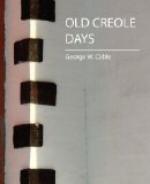The lady was quite handsome—had been more so, but was still young—spoke the beautiful language, and kept, in the inner room, her discreet and taciturn mulattress, a tall, straight woman, with a fierce eye, but called by the young Creoles of the neighborhood “confound’ good lookin’.”
Among les Americaines, where the new neighbor always expects to be called upon by the older residents, this lady might have made friends in spite of being as reserved as ’Sieur George; but the reverse being the Creole custom, and she being well pleased to keep her own company, chose mystery rather than society.
The poor landlord was sorely troubled; it must not that any thing de trop take place in his house. He watched the two rooms narrowly, but without result, save to find that Madame plied her needle for pay, spent her money for little else besides harpstrings, and took good care of the little trunk of Monsieur. This espionage was a good turn to the mistress and maid, for when Kookoo announced that all was proper, no more was said by outsiders. Their landlord never got but one question answered by the middle-aged maid:
“Madame, he feared, was a litt’ bit embarrass’ pour money, eh?”
“Non; Mademoiselle [Mademoiselle, you notice!] had some property, but did not want to eat it up.”
Sometimes lady-friends came, in very elegant private carriages, to see her, and one or two seemed to beg her—but in vain—to go away with them; but these gradually dropped off, until lady and servant were alone in the world. And so years, and the Mexican war, went by.
The volunteers came home; peace reigned, and the city went on spreading up and down the land; but ’Sieur George did not return. It overran the country like cocoa-grass. Fields, roads, woodlands, that were once ’Sieur George’s places of retreat from mankind, were covered all over with little one-story houses in the “Old Third,” and fine residences and gardens up in “Lafayette.” Streets went slicing like a butcher’s knife, through old colonial estates, whose first masters never dreamed of the city reaching them,—and ’Sieur George was still away. The four-story brick got old and ugly, and the surroundings dim and dreamy. Theatres, processions, dry-goods stores, government establishments, banks, hotels, and all spirit of enterprise were gone to Canal Street and beyond, and the very beggars were gone with them. The little trunk got very old and bald, and still its owner lingered; still the lady, somewhat the worse for lapse of time, looked from the balcony-window in the brief southern twilights, and the maid every morning shook a worn rug or two over the dangerous-looking railing; and yet neither had made friends or enemies.




